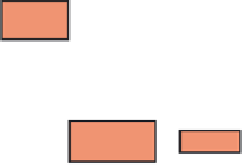Environmental Engineering Reference
In-Depth Information
PHOSPHATE
ROCK
RESERVES
Losses: non-arable
soil, landfill, water
NATURAL ENVIRONMENT
(biomass, land, water)
Vegetation
Grazing
12.1
ANTHROPOSPHERE
(food-related
human activity)
17.5
0.9
7
Livestock feed additives
15
Animal
manure
Domestic
animals
0.6
8
2
Crop residues
2.6
14.9
14
12
7
3.5
3
Mined
phosphate
rock
P
fertilizer
production
Losses;
landfill
(sludge)
non-
arable soil
Arable
soil
*
Harvested
crops
Food
commodities
Crops
Humans
3
0.9
1.2
1.2
1.8
Human
excreta
Non-food
commodities
3
Organic
solid waste
Other industrial
uses
(e.g. detergents)
0.9
8
0.2
1
0.3
1.5
Wastewater or
excreta reuse
Mine losses:
wastes e.g.
phosphogyspsum
Distribution
losses
Erosion
losses:
(water,
atmosphere,
non-arable
land)
Crop losses:
(pests/disease/
natural destruction,
burning, wild animal
consumption)
Post-harvest
losses
Food chain losses
(distribution, retail,
household or institutional
food waste)
Treated or
untreated
sewage
INLAND/
COASTAL
WATERS
= Industrial P flows occurring
at rate of days to years
= Recirculated P flows from organic
sources to arable land
= Natural biogeochemical P flows
occurring at rate of millions of years
FIGURE 8.4
Phosphorus flows through the global food production and consumption system (in Mt/year).
(From
Cordell et al. 2009
.)
manure, crop trade has facilitated the concentration of livestock production in regions
without enough land to grow the livestock feed or, therefore, enough land to assimilate
the resulting P-rich manures. Thus, moving P around the planet in fertilizers and agricul-
tural products has the effect of overfertilizing some soils while leaving others without the
nutrients required to grow crops.
Global P budgets, which subtract P uptake by crops and animals from P input in man-
ures and fertilizers, have shown that P is accumulating in agricultural areas due to the use
of fertilizers and animal feeds, increasingly so in some developing countries (
Bennett et al.
2001
). More recent global P budgets (
MacDonald et al. 2011
) have been able to examine
the build-up and decline in soil P in a more spatially explicit manner, finding P surpluses
on 70% of the world's cropland and P deficits on 30%, with both surpluses and deficits
found on every continent (
Figure 8.5
). Areas of surplus P are likely to have issues with
eutrophication and water quality because the excess P is available to runoff or leach into
nearby freshwaters. On the other hand, areas of deficit indicate regions that may have
reduced agricultural production. The largest imbalances are spatially concentrated—just
10% of the global cropland area with the largest deficits contributes 65% of the cumulative















































































